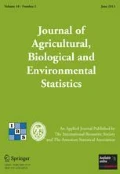Abstract
Deforestation in the tropics has been a major concern in conservation science for more than two decades. A standard explanation is population pressure, argued through descriptive statistical summaries, but the connection between local population and forest exploitation has not been clearly addressed from a formal modeling perspective. We implement such modeling here using a two-stage specification. At the first stage, we provide a spatial model for population counts. At the second stage, we provide a conditional spatial model for land use given population. A critical problem is misalignment. The population counts are recorded at various administrative unit levels. In particular, we work with twon-level counts. The land-use classifications are from remotely sensed satellite images and are provided at a 1-km × 1-km pixel level. We propose a methodology to implement regressions in this situation. The motivating data are obtained for the tropical wet forest on the eastern coast of Madagascar. This is a designated hotspot rain forest featuring high species diversity and high endemism. A fairly detailed analysis connecting land use with population data for this region is presented.
Similar content being viewed by others
References
Albert, J., and Chib, S. (1993), “Bayesian Analysis of Binary and Polychotomous Response Data.” Journal of the American Statistical Association, 88, 669–679.
Besag, J. (1974), “Spatial Interaction and the Analysis of Lattice Systems” (with discussion), Journal of the Royal Statistical Society, Series B, 36, 192–236.
Besag, J., Green, P. J., Higdon, D., and Mengersen, K. (1995), “Bayesian Computation and Stochastic Systems” (with discussion), Statistical Science, 10, 3–66.
Brown, K., and Pearce, D. W. (eds.) (1994), The Causes of Tropical Deforestation. Vancouver: University of British Columbia Press.
Chomitz, K. M., and Gray, D. A. (1996), “Roads, Land Use, and Deforestation: A Spatial Model Applied to Belize,” World Bank Economic Review, 10, 487–512.
Cressie, N. A. C. (1993), Statistics for Spatial Data (rev. ed.), New York: Wiley.
Davies, S. D., Heywood, V. H., and Hamilton, A. C. (eds.) (1994), Centers of Plant Diversity: A Guide and Strategy for Their Conservation (Vol 1), Europe, Africa, Southwest Asia and the Middle East, Cambridge, U.K.: International Union for the Conservation of Nature (IUCN).
Gelfand, A. E., and Smith, A. F. M. (1990), “Sampling Based Approaches to Calculating Marginal Densities,” Journal of the American Statistical Association, 85, 398–409.
Granger, A. (1998), “Modeling Tropical Land Use Change and Deforestation,” in Tropical Rain Forest: A Wider Perspective, London: Chapman and Hall.
Green, G. M., and Sussman, R. W. (1990), “Deforestation History of the Eastern Rain forests of Madagascar From Satellite Images,” Science, 248, 212–215.
Leach, G., and Mearns, R. (1988), Beyond the Fuelwood Crisis: People, Land and Trees in Africa, London: Earthscan.
Lowry, P. P., Schatz, G. E., and Phillipson, P. B. (1997), “The Classification of Naturaa and Anthropogenic Vegetation in Madagascar,” in Natural Change and Human Impact in Madagascar, eds. S. M. Goodman and B. D. Patterson, Washington, DC: Smithsonian Institute Press, pp. 93–123.
Mercier, J.-R. (1991), La Deforestation en Afrique: Situation et Perspectives. Aix-en-Provence, France: Edisud.
Meyers, N. (1991), “The Biodiversity Challenge: Expanding Hotspots Analysis,” Environmentalist, 10, 243–256.
Mittermeier, R. (1988), “Primate Diversity and the Tropical Forest: Case Studies From Brazil and Madagascar and the Importance of the Megadiversity Country,” in Biodiversity, ed. E. O. Wilson, Washington, DC: National Academy, pp. 145–154.
Mugglin, A. S., and Carlin, B. P. (1998), “Hierarchical Modeling in Geographic Information Systems: Population Interpolation Over Incompatible Zones,” Journal of Agricultural, Biological, and Environmental Statistics, 3, 111–130.
Mugglin, A. S., Carlin, B. P., and Gelfand, A. E. (2000), “Fully Model Based Approaches for Spatially Misaligned Data,” Journal of the American Statistical Association, 95, 877–887.
Olson, S. H. (1984), “The Robes of the Ancestors: Forests in the History of Madagascar,” Journal of Forest History, 28, 174–186.
Palloni, A. (1992), “The Relation Between Population and Deforestation: Methods for Drawing Causal Inferences From Macro and Micro Studies,” CDE Working Paper 92-14, Center for Demography and Ecology: University of Wisconsin, Madison.
Richards, J. F., and Tucker, R. P. (1988), World Deforestation in the Twentieth Century, Durham, NC: Duke University Press.
Sponsel, L. E., Headland, T. N., and Bailey, R. C. (1996), Tropical Deforestation: The Human Dimension. New York: Columbia University Press.
Torsten, A. (1992), Deforestation of Tropical Rainforests: Economic Causes and Impact on Development, Tubingen: J.C.B. Mohr.
Whitmore, T. C. (1992), Tropical Deforestation and Species Extinction, New York: Chapman and Hall.
Author information
Authors and Affiliations
Rights and permissions
About this article
Cite this article
Agarwal, D.K., Gelfand, A.E. & Silander, J.A. Investigating tropical deforestation using two-stage spatially misaligned regression models. JABES 7, 420–439 (2002). https://doi.org/10.1198/108571102348
Received:
Accepted:
Issue Date:
DOI: https://doi.org/10.1198/108571102348




